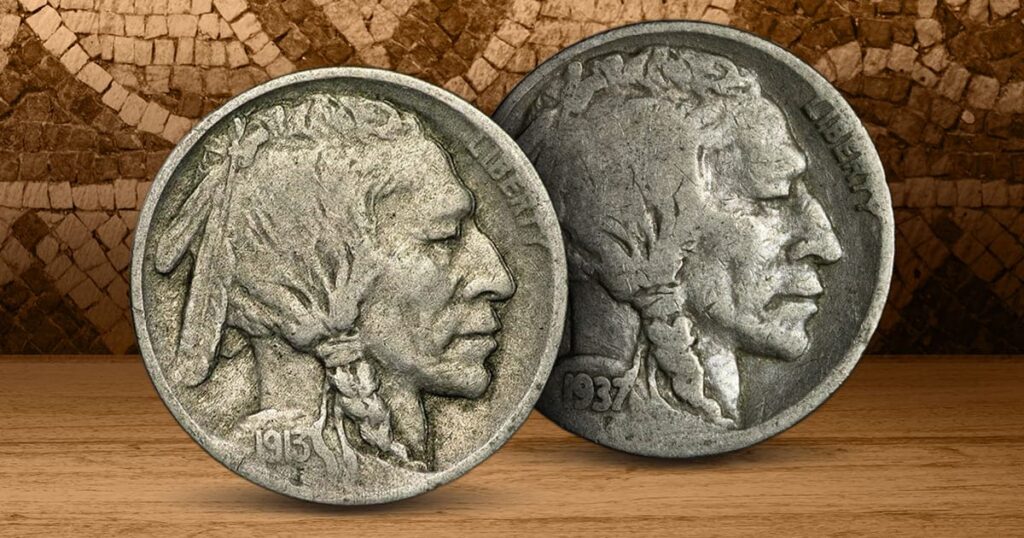
In today’s world of Numismatics, the Buffalo Nickel is considered an iconic American coin. What could be more American than a Native American Indian chief on the obverse of the coin and an American Bison on the reverse? It is one of the most American-looking coins in the general opinion of American collectors and dealers today. But when the coin was first struck in 1913, it was not universally appreciated, and many article and story writers disliked the design. In fact, the U.S. Mint receives numerous complaints about it.
You would be quite mistaken if you think the complainants were all “uneducated members of the public,” people who didn’t appreciate any changes to coin designs. The American Numismatic Association (ANA) is the largest coin organization in the world and one of the most influential. Its members influenced coin design in several circulating coins, most notably the idea of striking a “Peace” Silver Dollar. The ANA publishes a monthly publication called “The Numismatist.”
The U.S. Mint shared a rough draft of the proposed nickel design with the ANA (the American Numismatic Association) published in The Numismatist. Edgar Adams. Some of Mr. Adams’ comments are as follows:
“The design is radically different from that of any five-cent piece that has ever been issued at the Mint and is slightly concave on both sides, somewhat like the present ten and twenty-dollar pieces. Directly under figure “3” of the date 1913 on the obverse is the letter “F” for the designer of the piece, James Earl Fraser of New York City. It is said that Mr. Fraser took as a model an Indian of the Cheyenne tribe who recently visited New York City. The bison was modeled after a specimen in the New York Zoological Garden.
Mr. Fraser, the designer, is reported as saying that the capital “F” below the date has met with the approval of the Secretary of the Treasury, the Director of the Mint, and also the National Art Commission.
Already, it is said, the presence of this tiny letter has aroused a certain amount of criticism, similar to that which greeted the appearance of the letters “V. D. B.” on the Lincoln cent, which resulted in their removal, doing an injustice to Mr. Brenner, its designer, and violating all precedents.
The new piece certainly has radically changed the old-time tradition that Columbia is our best representation of “liberty.” In view of the rather restricted character of both the Indian and the buffalo today, it is an open question whether either is a good symbol of “liberty.”
We still prefer Miss Columbia as the proper representation of freedom and regret that she does not appear in the new five-cent piece. For instance, the date and the motto are in such obscure figures and letters that the slightest wear will obliterate them beyond understanding.”
From this one gentleman at the ANA, there were complaints about the concave shape of the coin, the designer’s initial, using a Native American to represent “Liberty,” and the fact that the date and motto could wear away quickly.
That last comment was valid; after 38 million 1913-Dated nickels were struck at the three mints combined – Philadelphia, Denver, and San Francisco – the designs were changed to include the Buffalo no longer standing on a mound and a line above the denomination and a stronger date.
A letter writer to “The Numismatist” complained that the motto “E PLURIBUS UNUM” was crowded onto three lines on the reverse while it could have been entirely omitted. He also complained that the motto “IN GOD WE TRUST” was suddenly missing from the nickel. But he didn’t realize that that motto did not also appear on its predecessor – the Liberty (or “V”) nickel.
Some writers complained the full figure of the Buffalo was too large for the coin and should be eliminated and replaced with the numeral “5”.
Even the venerable New York Times newspaper published an editorial that stated:
“The new ‘nickel’ is a striking example of what a coin intended for wide circulation should not be … [it] is not pleasing to look at when new and shiny and will be an abomination when old and dull.”
Once again, the New York Times objected to representing Miss Liberty as anything but the traditional goddess figure used since the first coins in 1793.
But the design needed embellishments to make the coin’s details visible after prolonged circulation. This is why “dateless” Buffalo Nickels are a relatively common item today. That weakness in the design created many Buffalo Nickels that no longer bear their original date of birth on their obverse.
Between their artistic and evolutionary design and the difference between this coin and its predecessors, the American public wasn’t truly ready for this new design when it appeared in 1913. However, this coin has become appreciated and loved over the succeeding decades as a truly iconic American coin.
Between the “wear” issue and the numerous complaints, the U.S. Mint initially sought to either radically change this design or make this coin a one-year commemorative and not a circulating issue. But the Mint’s fears were unfounded, and the nickel surged in commerce usage and public popularity. The 1913 Buffalo Nickel is now considered one of our most popular coin designs. James Earle Fraser’s iconic design is more popular today than ever before.





